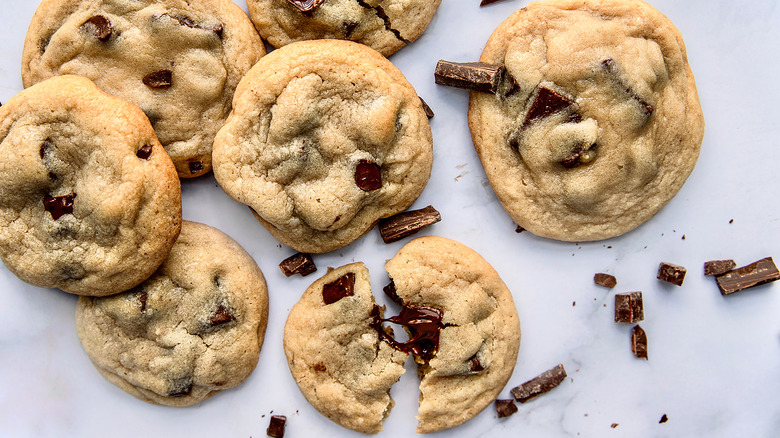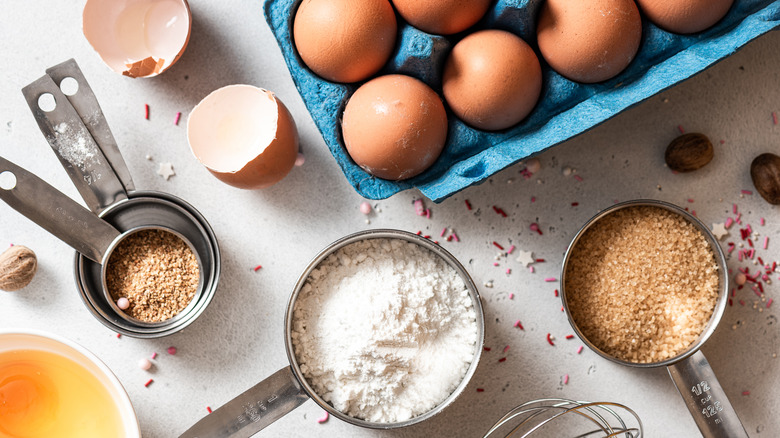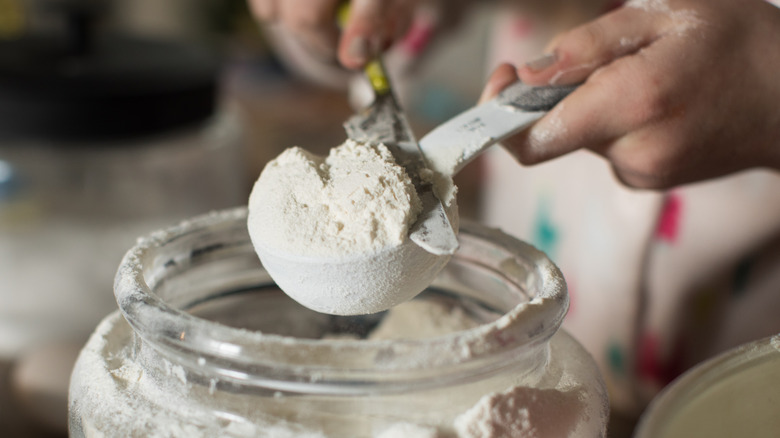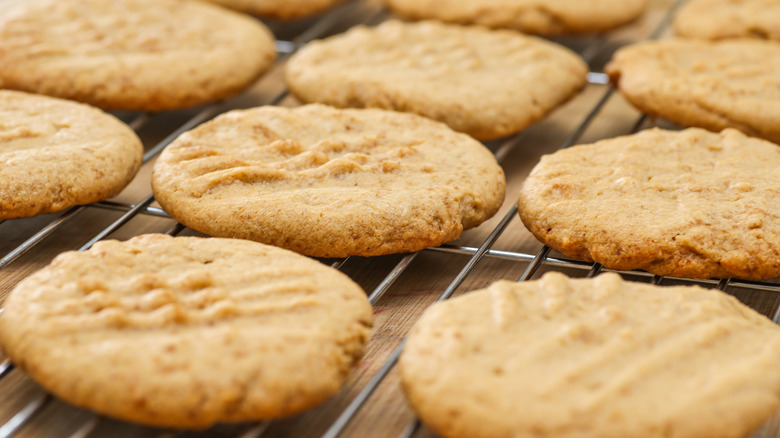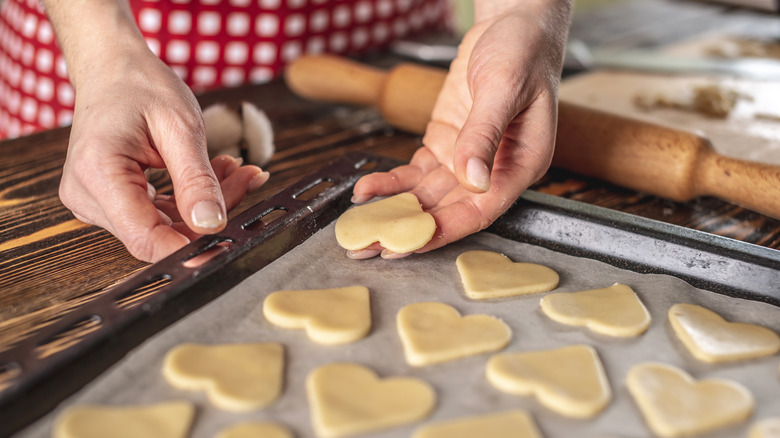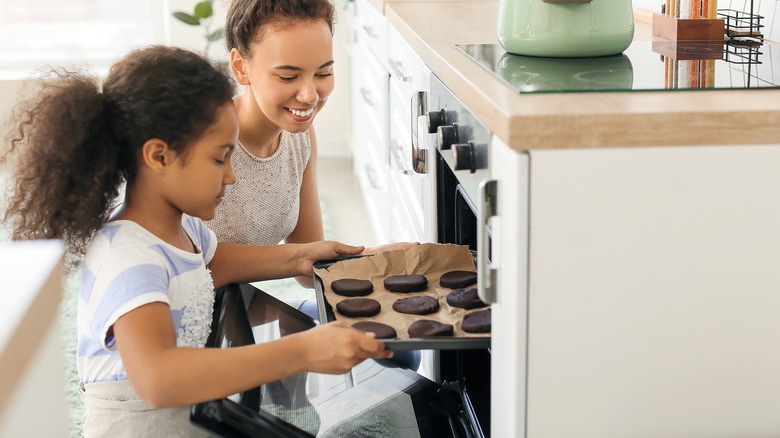Cookie Baking Mistakes Everyone Makes
Baking cookies is perhaps the most traveled path in the complicated science of baking. Compared to its more difficult relatives like cake, pie, and bread, cookies are an approachable bake and the most likely to result in immediate gratification, as they're often quick to prepare and easy to share. In "The Professional Pastry Chef" by Bo Friberg, we learn that the word cookie comes from the Danish word, koekje, meaning "small cake." While the translation may suggest something uncomplicated, there are recurring mistakes made by many at-home bakers that lead to disappointing cookie results. To point you on a path towards victory, we have identified a few places where things can easily go wrong so that you can overcome the usual hurdles between you and your next batch of fresh, warm cookies!
While some of the recipe details may seem unimportant two or three steps into the process, the impact of these on the final cookie is significant. You might think using premade cookie dough would be a foolproof path towards perfect cookies, but even with ready-to-bake dough these common cookie baking mistakes can hold you back from baking bliss. The difficulty of cookie recipes is vast, spanning from basic sugar cookies to more complicated pinwheel cookies to the most challenging, French macarons. Even though techniques and processes may vary in complication and style from recipe to recipe, there are a few general principles and methods that remain consistent and — if followed — can help avoid mistakes in the baking process.
Not checking the quality of your ingredients
Before beginning the mixing and preparation process, check to see what you have in stock in your pantry. There is nothing worse than realizing you only have one cup of flour when you need two, or that you're out of chocolate chips 70% of the way through your recipe. As with any cooking or baking endeavor, prepare your mise en place, pull out all the ingredients identified by the recipe and check the stock levels of each item. Gather your mixing bowls, line the baking sheets, and preheat your oven so you are ready and collected for the process; preparing ingredients and equipment increases the likelihood of success.
As you pull out the ingredients be sure to examine the freshness and quality of each item, checking expiration dates. Despite the long shelf life of many baking ingredients, they are perishable and can become stale with time — this step is especially important for baking powder and baking soda. According to The Kitchn, baking powder and baking soda act as leavening agents in the baking process and are necessary for the correct chemical reactions to happen in the oven. If these two ingredients are not fresh, the desired reaction will not take place which can spoil the cookies' taste, texture, and appearance. To know if baking soda or baking powder is past its prime, look for the expiration date on the container or use the hot water and vinegar test. To use this method, simply mix hot water and vinegar with some of the soda or powder; if it begins to fizz it is still active, if not you should toss it and get a new container.
Mismeasuring ingredients
Most baking recipes from the U.S. list ingredient amounts in cups, tablespoons, and teaspoons, but this broad style of measure can lead to varied results. When shopping at the market, there are many different types of flour like all-purpose, whole wheat, and pastry, not to mention gluten-free options like almond, coconut, or rice flour. King Arthur Baking Company states that depending on the type of flour, the density, protein content, liquid absorbency, and gluten development will vary significantly.
Not only do flour types vary, but techniques for measuring deviate as well. According to Cook's Illustrated, the measuring technique used to scoop one cup of flour can vary as much as 20% from person to person. Do you scoop and level or dig into the container with your cup? The best way to overcome this variable is to use a scale. You can convert the measurements into ounces or grams using online baking conversion charts like this one from Allrecipes if you need to do so (for recipes from outside the U.S., you will likely already be given the weight measurement). While this step may seem too detailed for many at-home bakers, the precision of weighed ingredients produces replicable recipes which can be shared with confidence and produce consistent results.
Practice patience
There is a desire to rush through simple seeming recipes, like those for sugar or peanut butter cookies; but moving with haste can encourage shortcuts and ignoring specifics like bringing butter or eggs to room temperature (70 degrees Fahrenheit, says Epicurious). Though Bon Appétit says there are ways to accelerate the warming process, no matter what you'll need to prepare for some additional time spent waiting around.
Another part of your recipe you won't want to rush? According to Serious Eats, creaming butter and sugar properly is important, as it creates small air pockets in the dough, resulting in a few more cookies per batch. Patiently wait for an airy texture, about five minutes with an electric mixer, before the next step.
Once your dough is prepared, another test of patience arises when it's time to chill the dough before baking. According to Taste of Home, this step solidifies fats, concentrates flavors, and controls spread of your cookies. Despite the temptation to throw just made dough straight into the oven, this is not the step to skip. Even 30 minutes chilling can make a noticeable difference in taste, size, and shape.
Of course, the ultimate test of patience happens when cookies are pulled from the oven. The Spruce Eats explains moving too hot cookies can cause crumpling. It will be worth the wait to avoid a burnt mouth and achieve that perfect cookie shape.
Properly prepare your baking sheet
As a part of the mise en place preparation, lining your baking sheet is essential to keep cookies from getting stuck. There is nothing worse than pulling a cookie off your baking sheet, only to notice a chunk remains. Using parchment paper or a silicone baking mat can keep cookies from clinging. Some recipes require lining the baking tray with butter or baking spray, but resist the urge to over-grease. Betty Crocker explains that greasing can encourage cookies to spread, negating the time the dough chills in the refrigerator before baking (see: patience).
Be sure to let your cookies have ample space to expand and promote hot air circulation. Cramming as many cookies as possible on a baking tray could lead to cookies connecting into warped shapes.
In between batches, let your cookie sheet cool before starting a new batch. According to Betty Crocker, refrigerated cookie dough on a hot sheet can produce flat cookies. To hasten the cooling process in between bakes, you can place cookie sheets in the refrigerator. Having a few cookie sheets on hand can also speed up the baking rotations, as you'll be able to cool one while another is in the oven.
Lastly, the type of cookie sheet you use can impact baking results. Betty Crocker suggests a large, heavy-gauge, dull aluminum cookie sheet with low sides for the best results. Shiny, dark, or thin cookie sheets can negatively impact the distribution of heat in the baking process.
Avoid oven complications
According to The Kitchn, conventional ovens can estimate approximate temperatures at best, and there are hot spots and cool spots within most. Testing your oven by paying attention to baking patterns can help. The outlet recommends using sugar to figure out your oven's pattern. To do this, sprinkle sugar on a parchment-lined baking sheet and bake for 10 minutes at 400 degrees Fahrenheit, you'll be able to easily see the hot spots when you remove the sugar.
While obvious, forgetting to set a timer when baking can lead to disappointing results. (Once the smell of burnt cookies becomes detectable, it is too late.) Consider setting a timer for just half of the estimated bake time, so you can rotate your baking sheets halfway. Rotating is especially useful if you know your oven has hot and cold spots, says Bon Appétit. To estimate baking times for various cookie types, you can refer to a baking time chart, like this one from The Spruce Eats which includes variables from the thickness of the dough to the mix-ins.
While most cookies — even those with imperfections — taste delicious, less than ideal results could discourage you from graduating to the next level of baking. Once you know how to avoid these common mistakes, you'll have no problem taking your cookies from novice to expert.
